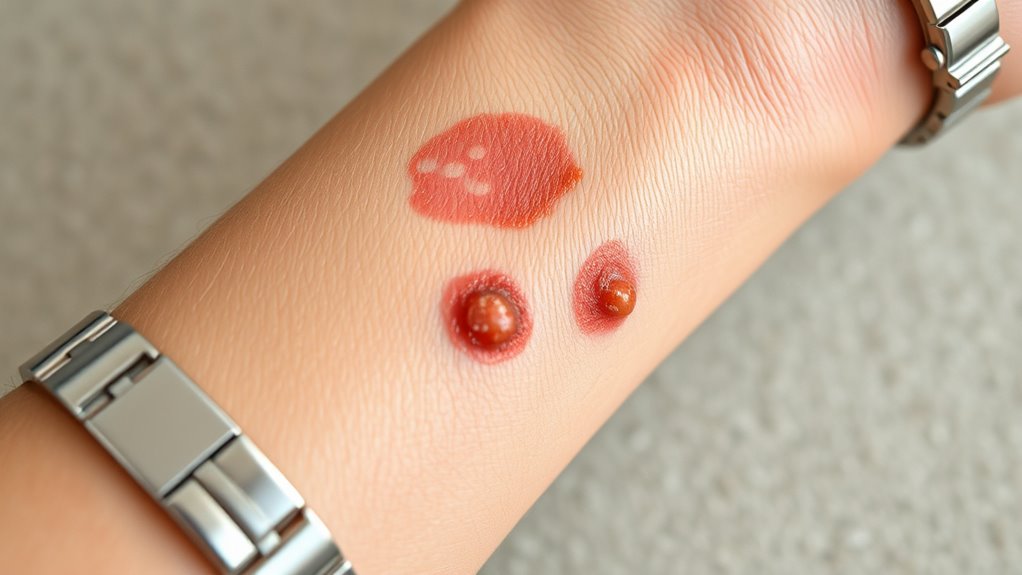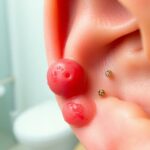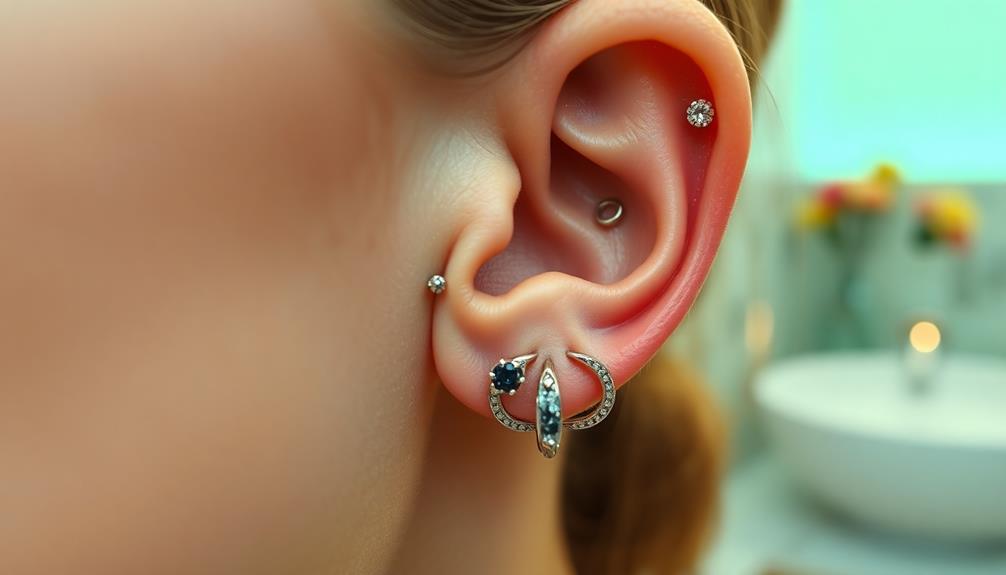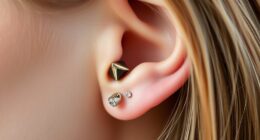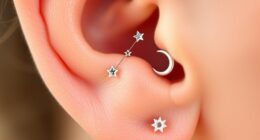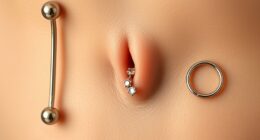If you experience redness, itching, swelling, or blisters where metal contacts your skin, you might have a metal allergy causing contact dermatitis. Nickel is a common trigger, but cobalt and chromium can also cause reactions. To prevent this, choose hypoallergenic jewelry made from materials like surgical stainless steel or titanium, and avoid metals known to cause allergies. Using barrier coatings or consulting a dermatologist can help protect your skin, and uncovering more tips can keep your skin safe and comfortable.
Key Takeaways
- Recognize symptoms like redness, itching, swelling, and blisters at contact sites to identify metal-induced contact dermatitis.
- Nickel, cobalt, and chromium are common metals causing allergic reactions; repeated exposure increases sensitivity.
- Use hypoallergenic jewelry made from surgical stainless steel, titanium, or niobium to prevent reactions.
- Applying clear nail polish on jewelry can serve as a temporary barrier against allergenic metals.
- Remove jewelry promptly if signs of allergy appear and keep skin clean and dry to reduce irritation.
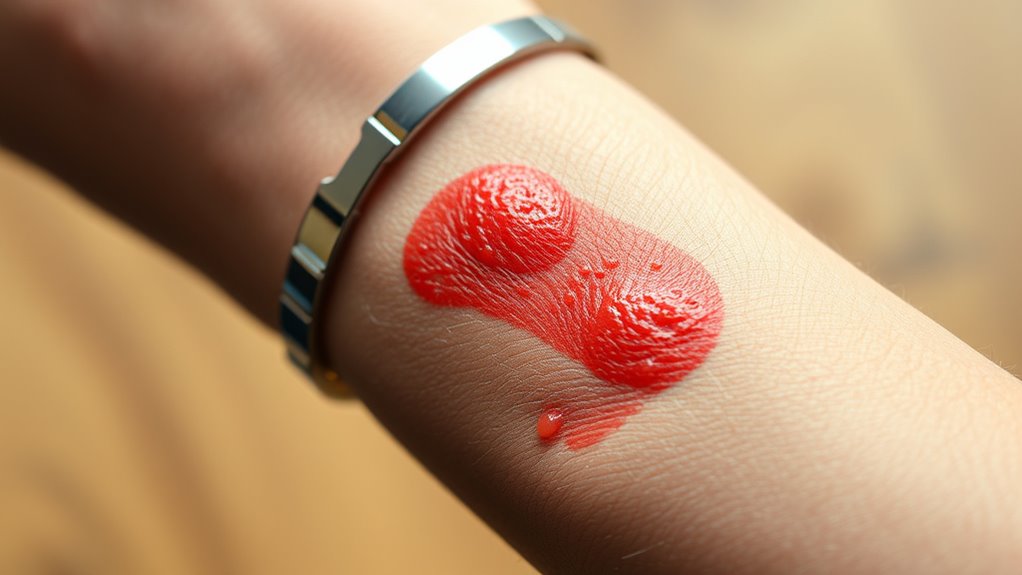
Many people develop allergic reactions to metals, often without realizing it until symptoms appear. Metal hypersensitivity is a common cause of contact dermatitis, especially when it comes to jewelry allergies. You might wear a ring, bracelet, or necklace daily, not suspecting that your skin is reacting to the metal. Over time, you could notice redness, itching, swelling, or even blisters in areas where your skin contacts the jewelry. These signs are classic indicators of an allergic response triggered by metal exposure. Recognizing that jewelry allergies are a form of metal hypersensitivity helps you understand that your skin’s reaction isn’t due to poor hygiene or other irritants but specifically to the metals used in your accessories.
Certain metals are more likely to cause allergies than others. Nickel, for example, is notorious for provoking allergic reactions and is frequently found in inexpensive jewelry. When your skin comes into contact with nickel, your immune system may recognize it as a threat, leading to inflammation and discomfort. Other metals like cobalt and chromium can also cause similar reactions, though less often. If you notice persistent itching or rash after wearing jewelry, it’s worth considering whether you might have a metal hypersensitivity. This type of allergy often develops over time with repeated exposure, meaning you may not have had an issue initially but gradually became sensitive.
To prevent jewelry allergies, you should be mindful of the materials in your accessories. Opt for jewelry made from hypoallergenic metals like surgical stainless steel, titanium, or niobium. These materials are less likely to trigger a reaction because they contain fewer allergenic metals like nickel. When shopping for jewelry, check product descriptions for mentions of hypoallergenic qualities or nickel-free labels. If you already suspect a metal hypersensitivity, consider coating jewelry with a clear nail polish as a temporary barrier, but keep in mind this isn’t a permanent solution. Consulting with a dermatologist can help you determine if you have a specific allergy and guide you toward safe alternatives.
Additionally, choosing appropriate materials can reduce your risk of developing or worsening a metal allergy. You should also pay attention to your skin’s signals. If you notice redness, itching, or swelling after wearing certain jewelry, remove it immediately. Keeping your skin clean and dry can help minimize irritation, but avoiding contact with problematic metals remains the most effective prevention. Recognizing the signs of jewelry allergies enables you to make smarter choices, reducing discomfort and avoiding more severe allergic reactions. Being proactive about metal hypersensitivity means you can enjoy wearing jewelry without risking ongoing skin issues.
Frequently Asked Questions
Can Metal Allergies Develop Later in Life Without Prior Exposure?
You might wonder if metal allergies can develop later in life without prior exposure. It’s possible because latent reactions can emerge over time, even if you weren’t allergic before. Genetic predisposition plays a role, meaning your immune system might suddenly become sensitive to certain metals. So, while it’s less common, developing a metal allergy later in life is still a real possibility, especially if your immune response changes or if you encounter new metals.
Are There Specific Metals More Likely to Cause Allergic Reactions?
Think of your skin as a delicate garden, vulnerable to certain metals that act like invasive weeds. Nickel sensitivity is the most common culprit, often hiding in jewelry reactions and causing eruptions. Metals like cobalt and chromium can also spark similar allergies. To protect your garden, opt for hypoallergenic jewelry and keep an eye out for metals that tend to trigger reactions, ensuring your skin stays healthy and vibrant.
How Long Does It Take for a Metal Allergy to Manifest?
The timing variability for metal allergy reactions varies from person to person. You might notice symptoms within minutes to hours if you’re highly sensitive, or it could take days to weeks for others. Reaction onset depends on factors like your immune response and exposure level. If you develop contact dermatitis, monitor your skin closely after metal contact, and seek advice if symptoms appear, regardless of how quickly they show up.
Can Metal Allergy Symptoms Be Mistaken for Other Skin Conditions?
You might mistake metal allergy symptoms for other skin conditions because of symptom overlap and cross-reaction confusion. Redness, itching, and rash can resemble eczema or dermatitis, making it tricky to identify the true cause. Pay attention to your exposure history and any jewelry or metal contact. If symptoms persist or worsen, see a dermatologist for proper diagnosis, as mistaken identity can delay effective treatment and lead to ongoing discomfort.
Are Hypoallergenic Metals Completely Safe for Sensitive Individuals?
You might think hypoallergenic metals are completely safe, but only about 10-15% of people with metal allergies react to them. While hypoallergenic claims suggest they’re less likely to cause reactions, individual sensitivities vary. Metal allergy testing can help determine your specific triggers. Remember, no metal is entirely risk-free; it’s best to consult with a dermatologist to find the safest options for your sensitive skin.
Conclusion
So, next time you wear that shiny ring or snazzy bracelet, remember, you’re inviting tiny metal warriors to wage war on your skin. Think of dermatitis as your body’s protest parade—coordinated and relentless. Preventing allergic reactions isn’t rocket science; it’s just about playing metal detective and ditching the villains. After all, who wants a jewelry-induced skin rebellion? Stay vigilant, and let your skin enjoy the bling without the drama!
I’m Gillian. I love piercings and tattoos- there’s something about the way they make your body look that just makes me happy. I started this blog to share my passion for piercings and tattoos with the world and to help people who are thinking of getting their first piercing or tattoo.
I’ve been writing about piercings and tattoos for a while now on piercings-body.com. I love sharing my knowledge with others and helping people make informed decisions about their bodies.

